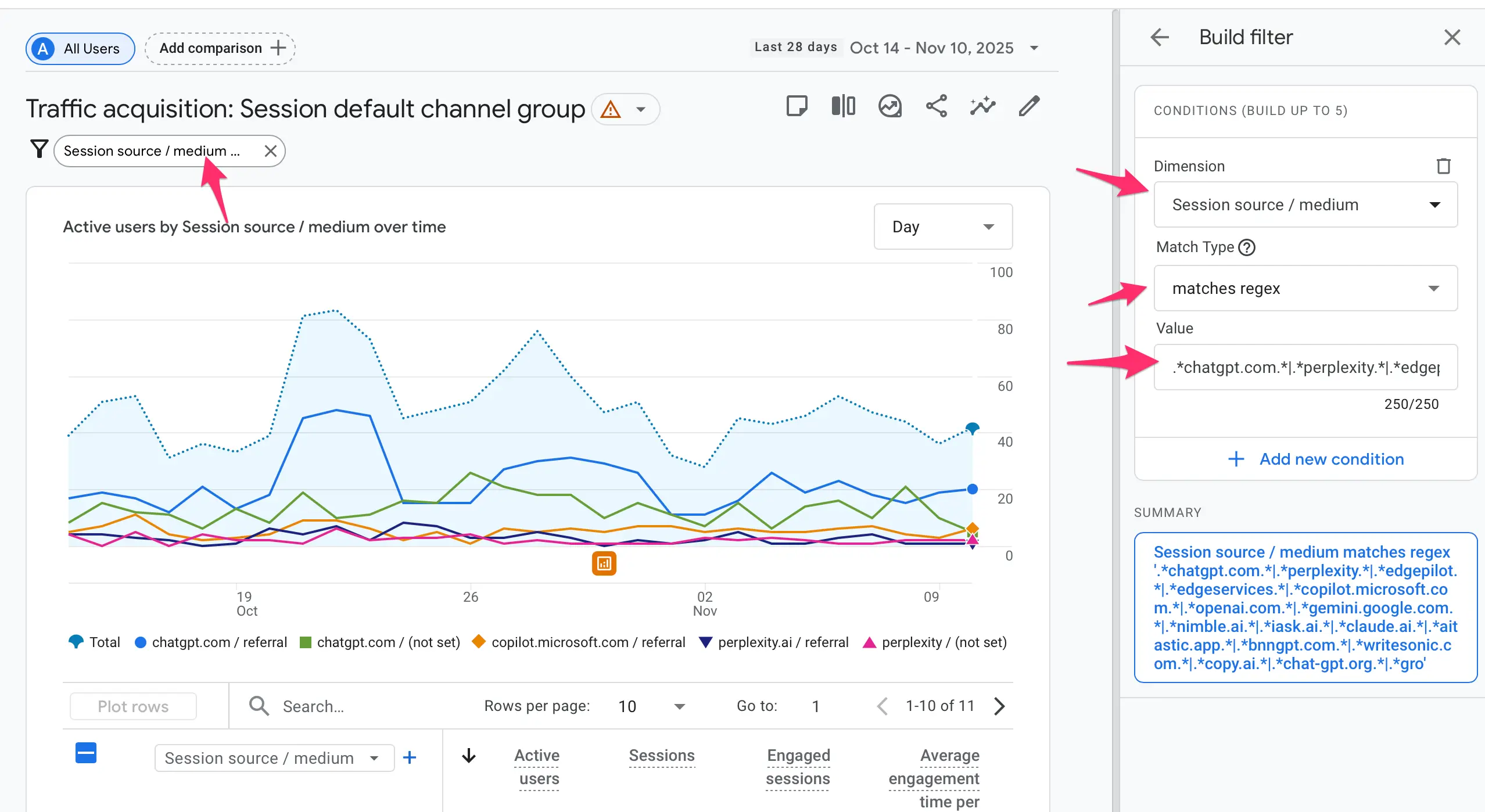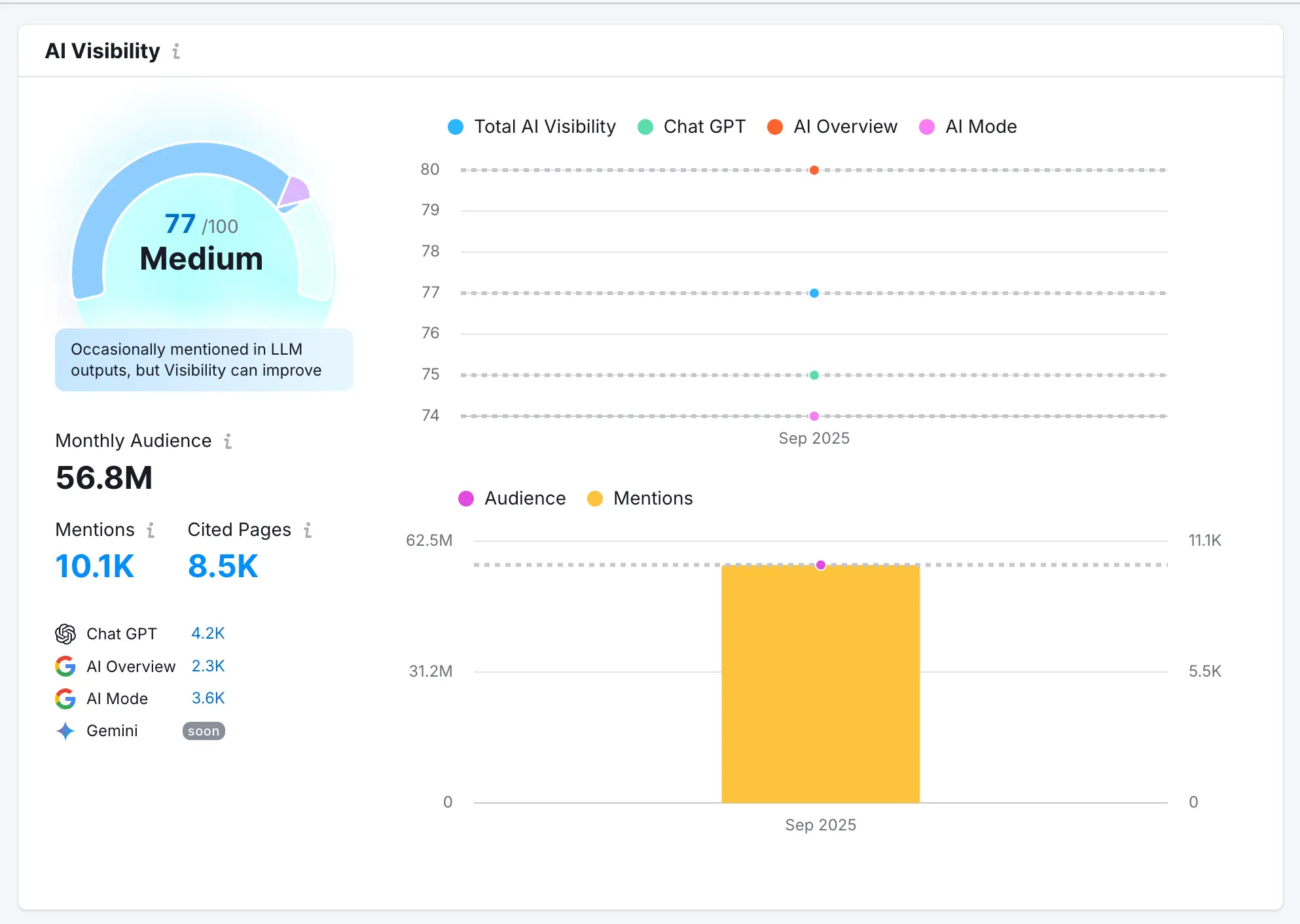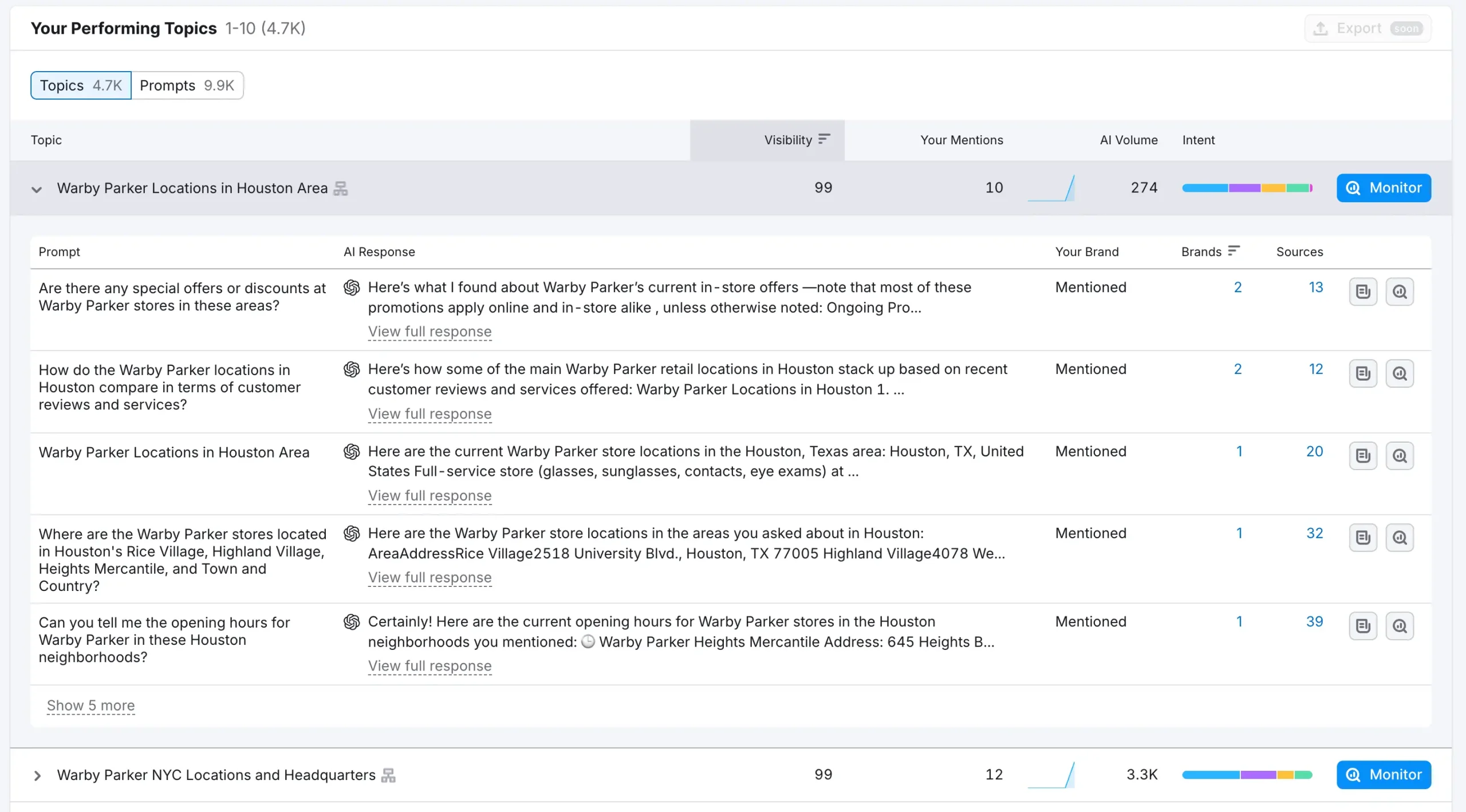How To Check Brand Visibility in AI Platforms
Disclaimer: This post contains affiliate links. I earn a commission if you make a purchase at no extra cost to you.
Online visibility is evolving. Traditional SEO rankings still matter, but AI platforms now influence how millions of people discover and evaluate brands.
With ChatGPT handling billions of queries every month, AI-driven discovery is becoming important for brands, and it’s only a matter of time before AI traffic surpasses traditional search.
The question is: when users ask AI about your industry, does your brand appear in the answers?
Tracking that isn’t as straightforward as checking your Google rankings. AI results change with every query, pulling information from multiple sources and presenting brands in new ways.
That’s why marketers need new ways to measure visibility.
In this guide, I’ll show you how to check your brand’s visibility in AI platforms, what metrics matter, and how to get reliable data without guesswork.
What Is AI Visibility and Why It’s Important
AI visibility measures the frequency and prominence with which your brand appears in AI-generated answers across platforms such as ChatGPT, Gemini, Copilot, and Perplexity.
Instead of ranking on a search results page, your brand is now competing to be mentioned or cited in AI search engines. These answers shape how users learn about products, compare options, and decide who to trust.
AI visibility matters because it’s becoming a key part of brand awareness and reputation. If AI platforms consistently mention your brand or cite your website as a source, you’re building authority with every query.
But if your competitors are showing up and you’re not, potential customers may never hear about you at all.
Monitoring AI visibility helps you understand:
- How often your brand is appearing in AI answers.
- What context or sentiment surrounds those mentions.
- Which competitors are being prioritized instead.
In short, AI visibility gives you a clear picture of how your brand performs in the new world of AI-driven discovery.
Check Your AI Visibility
Semrush One merges keyword-based SEO metrics with prompt-level AI search insights in one platform. Try Free for 7 Days.
AI Visibility Metrics You Should Track
Once you understand what AI visibility is, the next step is knowing how to measure it. AI platforms don’t show rankings like Google, so you need different metrics to understand how visible your brand really is.
Here are the key indicators that matter most:
AI Share of Voice – Shows how often your brand appears in AI-generated answers compared to competitors. It’s a snapshot of your overall presence across AI platforms.
AI Mentions – Tracks the total number of times your brand name appears in AI responses over time, helping you identify trends and growth.
AI Answer Citations – Counts how often AI platforms directly cite or link to your website as a trusted source. Citations boost both visibility and credibility.
AI Search Positioning – Shows where your brand appears relative to others in AI-generated summaries.
AI Sentiment – Analyzes the tone of your mentions (positive, neutral, or negative) to help you understand how AI systems represent your brand.
AI Referral Traffic – Tracks visits from AI platforms that include your links in their answers. You can view these referrals in analytics tools like Google Analytics.
AI Conversions – Measures how many leads or sales originate from AI-driven referrals or recommendations.
Depending on the tool or method you use, these KPIs might have slightly different names, but the goal is the same. You need to understand how your brand appears in AI answers, how competitors perform, and how your visibility changes over time.
How To Measure Brand Visibility Manually
If you want to get a quick idea of how your brand appears in AI responses without investing in a tool, you can start by tracking your AI visibility manually.
It won’t give you the full picture, but it’s a great way to understand where you stand and how users might see your brand through AI platforms.
Here’s how to approach it step by step:
1. Identify Relevant Prompts
Start by thinking about the kinds of questions your audience might ask an AI assistant, such as:
- “Best Digital Marketing tools or companies”
- “Alternatives to [competitor brand]”
- “Top [industry] platforms in [year]”
- “[your brand] reviews”
To generate more ideas for prompts, review your existing search data. Although search behavior in large language models (LLMs) is different from Google, your Google Search Console data can help.
Review the queries that already drive traffic to your site, as these indicate what users are interested in. Then, use those keywords as prompts to test how your brand appears in AI-generated responses.
2. Start With ChatGPT
ChatGPT is currently the most popular AI search engine by far, processing billions of queries every month. Begin there before expanding to others like Gemini, Perplexity, or Copilot. Trying to track all platforms at once manually is time-consuming and rarely consistent.
3. Use Temporary or Incognito Chats
AI responses are influenced by chat history, personalization, and sometimes even your location. To get cleaner results, use temporary chats (in ChatGPT) or incognito windows. Run each query multiple times and note whether your brand or your competitors appear in the generated answers.
You’ll likely see some variation each time, which highlights how dynamic AI visibility can be.
4. Log Your Findings
Create a simple spreadsheet to keep your research organized. Include columns for:
- Date
- Platform (ChatGPT, Gemini, etc.)
- Prompt or query used
- Whether your brand appears
- Mention type (brand name, link, citation)
- Competitors mentioned
- Sentiment (positive, neutral, negative)
Tracking this data every few weeks helps you spot changes. You will be able to understand whether your brand is appearing more often or being replaced by competitors.
5. Check AI Referral Data in Google Analytics
Finally, see how many visitors are reaching your site from AI platforms.
In Google Analytics 4, you can do this by:
- Navigate to Reports > Acquisition > Traffic acquisition.
- Click the Filter icon.
- Select Session source/medium as the dimension, and choose Matches Regex as the match type.
- Enter a regex like “.*chatgpt.com.*|.*perplexity.*|.*edgepilot.*|.*edgeservices.*|.*copilot.microsoft.com.*|.*openai.com.*|.*gemini.google.com.*|.*nimble.ai.*|.*iask.ai.*|.*claude.ai.*|.*aitastic.app.*|.*bnngpt.com.*|.*writesonic.com.*|.*copy.ai.*|.*chat-gpt.org.*|.*grok.x.ai.*”
- Click Apply to see the filtered results.
Review the sessions, engagement, and conversions associated with these sources.
This shows whether users are actually visiting your website from AI-generated responses or citations.
As you can see, manual tracking gives you a hands-on understanding of your AI visibility. However, it’s limited, results change constantly, and you can’t track trends automatically.
For a complete, reliable view, the next step is using a dedicated AI visibility tool. These tools let you monitor your brand’s presence, how you compare to competitors, and how your visibility evolves over time.
Some examples of AI visibility tools include:
- Semrush One – Combines both traditional SEO and AI visibility tracking in one platform, making it ideal for businesses transitioning into AI-driven discovery.
- Profound – Focuses on how AI answer engines cite brands, track prompts and citations, and optimise content for generative AI platforms.
- BrandLight – Tracks brand mentions across many AI engines (including ChatGPT, Gemini and others), monitors sentiment, share of voice and provides actionable insights.
- SE Ranking AI Visibility Tracker – A more focused, cost-efficient option for tracking brand mentions, AI links, and visibility gaps in AI answers.
- Peec AI – A newer tool that tracks brand visibility, sentiment and prompt performance across multiple AI models and platforms
- Otterly AI – Tracks brand mentions, citations, and sentiment across AI platforms like ChatGPT, Gemini, and Perplexity, turning keyword data into conversational prompt insights.
- RankScale AI – Monitors how brands appear in AI search results, benchmarks visibility against competitors, and provides optimization recommendations for AI-driven discovery.
These tools differ in depth (how many AI platforms they cover), cost, ease of use, and whether they integrate with your existing SEO workflows.
Check Your AI Visibility
Semrush One merges keyword-based SEO metrics with prompt-level AI search insights in one platform. Try Free for 7 Days.
For this guide, I’m using Semrush One because it integrates seamlessly into Semrush, and it’s the tool I’ve been using for decades for SEO analysis. That means you get both familiar workflows and new AI-visibility features in one place.
Here is an overview of the main tool features:
Visibility Overview
Provides a high-level snapshot of your brand’s visibility in AI answers: how often you appear, in what context, and how that compares to competitors.
Competitor Research
Lets you compare your brand’s visibility against rival brands: which prompts they show up for, which AI platforms cite them, where you’re falling behind.
Prompt Research
Shows which questions/prompts trigger mentions of your brand (or competitors), which prompts you’re missing, and where you can gain visibility.
Brand Performance
Tracks metrics like share of voice, number of citations, links from AI answers, trend over time: giving you a view of how your brand is doing in AI discovery.
Perception
Analyzes the tone and framing of how your brand is mentioned in AI answers: positive, neutral, or negative; what attributes are being emphasized.
Questions
Lets you see which user-questions your brand appears for, which you don’t appear for, and how you might optimise content or prompts to fill those gaps.
Final Thoughts
AI platforms are quickly becoming a major discovery channel, shaping how people find and evaluate brands. Understanding where your brand appears, and how often, is now just as important as traditional SEO tracking.
If you’re just starting out, begin with manual tracking. It’s free, simple, and helps you get a feel for how AI platforms describe your brand compared to competitors. You’ll see firsthand how prompts, brand mentions, and AI-generated answers can vary.
Once you’ve done that, consider investing in a dedicated AI visibility tool. Platforms like Semrush One, Profound, or Otterly AI make it possible to monitor visibility at scale, track trends over time, and uncover insights that would be missed manually.
AI visibility isn’t a passing trend; it’s the next stage of online brand measurement. The sooner you start tracking it, the better positioned your brand will be as AI-driven discovery becomes the norm.
Check Your AI Visibility
Semrush One merges keyword-based SEO metrics with prompt-level AI search insights in one platform. Try Free for 7 Days.







